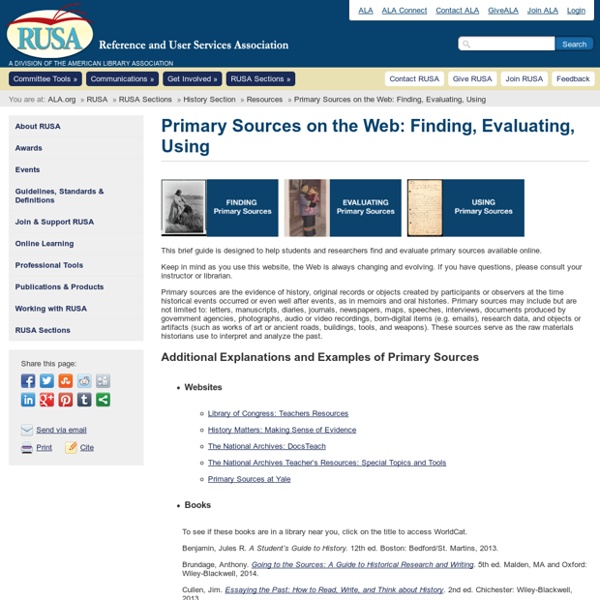Electronic Texts, Primary Sources and Digital Libraries
See Also: Archives & Manuscripts | Audio, Video, Multimedia | French Literature | History | Images | Literature | Magazines & Journals Looking for a particular title or author? Best starting place is the Online Books Page, John Mark Ockerbloom's index to full-texts on the Web with links to more than 30,000 books in various formats. ABU: la Bibliothèque Universelle - Over 288 searchable French e-texts, ranging from Balzac to Zola, listed alphabetically by author and title. Academy of Natural Sciences - Philadelphia. The Albert M.
Trans-Atlantic Slave Trade
Roll over names of designated regions on the map above for descriptions of the role of each in the trans-Atlantic slave trade. The North American mainland played a relatively minor role in the trans-Atlantic slave trade. Its ports sent out less than five percent of all known voyages, and its slave markets absorbed less than four percent of all slaves carried off from Africa. An intra-American trade in slaves – originating in the Caribbean - supplied additional slaves, however. This region was exceptional in the Americas in that a positive rate of natural population growth began relatively early, thus reducing the dependence of the region on coerced migrants.
Sanborn® Fire Insurance Maps
Sanborn® Fire Insurance Maps for Georgia Towns and Cities, 1884-1922 consists of 4,445 maps by the Sanborn Map Company depicting commercial, industrial, and residential areas for 133 municipalities. Originally designed for fire insurance assessment, the color-coded maps relate the location and use of buildings, as well as the materials employed in their construction. The maps indicate which city utilities--such as water and fire service--were available. Fire insurance maps document the changing face of towns and cities, providing highly detailed information for each neighborhood and block. The Library of Congress web site refers to them as "probably the single most important record of urban growth and development in the United States during the past one hundred years."
The National Security Archive
December 9, 2014 Torture Report Finally Released Senate Intelligence Committee Summary of CIA's Detention and Interrogation Program Concludes CIA Misled Itself, Congress, the President about Lack of Effectiveness. September 28, 2014
A timeline of wars of the United States
For most of its nearly two and a half century history, the United States has been at war. Some of these wars, like the American Civil War, were terrible and bloody and well-remembered. Others, like the Powder River War, were small and mostly forgotten. One was the result of an individual military officer disregarding orders and invading Mexico to retrieve stolen cattle. The consistency of war, and the dissimilarities of the impact and cost of each war, tend to lead to framing war in terms of casualties.
Radcliffe Institute for Advanced Study at Harvard University
The Schlesinger Library holdings date from the founding of the United States to the present and include more than 3,200 manuscript collections, 100,000 volumes of books and periodicals, and films, photos, and audiovisual material. Researchers travel from around the world to use the manuscript collections of Julia Child, the Boston Women's Health Book Collective, Maud Wood Park, and Betty Friedan or to examine comics like Ms. Marvel and periodicals like Bust.
Black Lives Matter Movement
Demonstrators filled the Mall of America rotunda and chanted “Black lives matter” to protest police brutality, Saturday, Dec. 12, 2014, in Bloomington, Minn. The group Black Lives Matter Minneapolis had more than 3,000 people confirm on Facebook that they would attend. Attendance figures weren’t immediately available. (AP Photo/The Star Tribune, Aaron Lavinsky)
Black Studies Collection
The library’s Black Studies collection has a rich history dating back to student activism and the Civil Rights Movement of the 1960s. In the fall of 1968, African American students at UCSB occupied North Hall and demonstrated against the systematic exclusion of Black Studies from university courses. The university administration accepted demands for the establishment of a Department of Black Studies. In conjunction with this, the Center for Black Studies was created to monitor, coordinate, support, and encourage research in the community. The collection houses materials on a variety of topics related to Africa and the African Diaspora in the United States and the Caribbean. Topics covered in the collection include anthropology, biography, music, theater, literature, and history.



